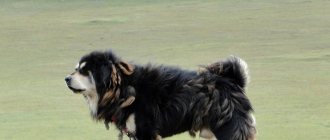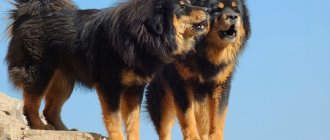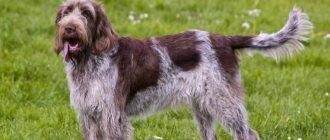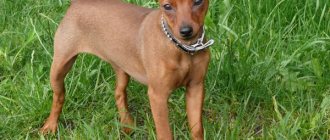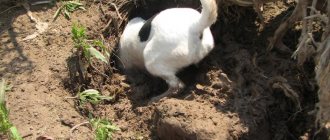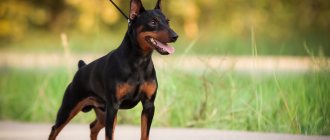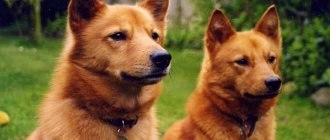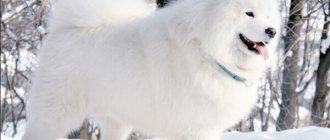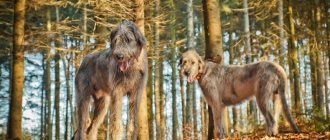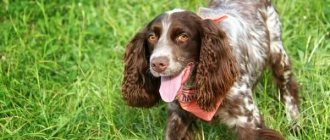Many dog lovers know that the Tibetan Mastiff is considered the most ancient breed and the progenitor of many dog breeds.
However, there is another little-known breed, which, as a result of recent research, can claim to be the oldest.
This is a Buryat-Mongolian wolfhound or Khotosho. She is poorly known among non-professionals. Let's talk about this dog, what it looks like, where it came from, whether it can be kept at home and learn other interesting facts.
Photo: wikimedia.org
History of the origin of the breed
Since ancient times, Khotosho were widespread in Central Asia, Tibet, Buryatia and Mongolia. They were faithful companions of man in all spheres of his life: hunting, guarding home and livestock, as a huge nanny for the owner’s children.
It is interesting that many legends are associated with this breed, or rather its origin.
The most famous of them:
- The ancient ancestor of the breed, a female Buryat-Mongolian wolfhound named Sarama, served directly the god Indra. She was distinguished by a special black and tan color. But the main feature was the presence of red spots on the dog’s forehead, which were located surprisingly symmetrically above the eyes. This gave the impression that the dog had four eyes. The ancient Buryats believed that a dog brings happiness to the house in which it lives. This belief has survived to this day;
- Khotosho once saved people from starvation by persuading Buddha to save grain on ears of grain.
Currently, animals of this breed occupy a special place in Buddhism. They are revered as sacred.
The formation of the breed proceeded through natural selection. Almost no selection was carried out. Except for selecting the strongest puppies from the litter. By the end of the 20th century, the breed was in danger of extinction. No one was involved in breeding.
The revival of the breed is associated with the activities of two enthusiasts: Marika Teregulova and Nikolai Batov. They organized expeditions to remote areas of Buryatia, where representatives of the breed could still be found. Breeding nurseries were organized in which the first offspring were obtained.
They created the breed standard. True, so far it has not been possible to achieve official recognition, and the breed is still considered rare. But she is no longer in danger of disappearing.
In addition to the most famous and official name, you can hear such names as: Mongolian Shepherd, Caucasian, Hun dog, Tibetan dog or simply wolfhound.
Photo: topsimages.com
Walking and physical activity
Even if the Buryat Mongolian Wolfhound lives on the street, it still needs walks. It is not worth keeping him in an enclosure all the time. Walking is necessary to keep your dog physically fit. Deprived of walks, the hotos become angular and less powerful.
The dog is large in size and therefore capable of causing serious harm to others. You need to walk her on a leash and muzzle. You can play with a ball while walking.
It is important! The Mongolian Shepherd cannot be kept on a chain, otherwise the dog’s psyche will suffer.
Description of the breed
The breed standard was established in 2006.
Breed requirements:
- Males always exceed females in size. Height at the withers: male - not less than 0.74 meters, female - not less than 0.66 meters. The dog is considered large and the weight of a male dog can reach up to 80 kilograms.
- The head is large, with well-defined cheekbones;
- The legs are very muscular, above average length;
- The dog's body is developed, with large muscles, barely noticeable under thick fur;
- The ears are triangular, medium in size, hanging;
- The eyes should be oval shaped. Color - from amber to dark brown. There are wolfhounds with blue eyes, which is considered a breed defect;
- Scissor bite. The dog's teeth should be very white, tightly adjacent to each other;
- The coat is quite hard combined with a dense soft undercoat;
- There are types: with long hair (hair length up to 30 cm), medium hair (up to 10 cm) and short hair (up to 5 cm). Despite the difference in coat length, all individuals shed equally heavily;
- The classic color is black and tan with a small white spot on the chest. It is preferred, but brown, brown, gray, black colors in various combinations are allowed;
- It is believed that Khotosho is a crossbreed of the Buryat-Mongolian wolfhound; less stringent requirements are imposed on them.
Difference between Khotosho and Bankhar
Often these two concepts merge and it is believed that these are two names for the same breed. This is wrong. Khotosho is a mixed breed, a yard dog. The word “hotosho” itself is translated from Buryat as “yard dog”, “yard guard”.
But the bankhar is a dog that carries all the characteristics of a pure breed. From the Mongolian language it is translated as “puffy”, “fluffy”, “filled with wool”.
They differ in appearance: the bankhar is larger than the bankhar, because the Mongols strictly observe the size of dogs; excess weight will interfere with the bankhar's movement.
Photo: bankhar.org
Intelligence and training
The Mongolian wolfhound is distinguished by its developed intelligence and ability to train. Dogs can be trained from 2 months of age. Animals of this breed are good at learning various commands and understanding what is expected of them. When training a dog, owners use more humane and restrained methods, because otherwise the dogs grow up fearful and intimidated. Training begins with the following commands:
- "near". It allows the dog to stick to the owner and move away from the leg only with permission;
- "ugh". Indicates a prohibition on any action, it is pronounced in a rude tone;
- “sit”/“lie down”. When the command “sit” is given, the owner places his palm close to the dog’s muzzle. When asked to “lie down,” you will initially need to help the wolfhounds take the desired position. But after a few lessons they will learn to carry out the command themselves.
All the merits of dogs should be encouraged by the owners. It is important for dogs to understand that the owner is happy and sees progress in training. Training shouldn't take too much time. If they are very tired, the next time the Buryat-Mongolian wolfhounds will go to training reluctantly. It is better to start training with the help of a professional. Beginners in this business make mistakes and lay the wrong foundations in the character of animals. This is especially true for owners with a gentle character, who constantly make concessions for their dogs.
Character and behavioral characteristics
A feature of the breed is the late maturation of individuals. The animal becomes fully formed psychologically only by the age of three. Males mature later than females. But this does not prevent them from performing their basic functions at a very young age. Even the smallest puppy will protect its territory, its owner and his family members.
You need to understand that the wolfhound is very human-oriented and it will not be enough for him to see his owner only during feeding and walking. He needs mandatory daily communication, play and affection from a person.
These hulks, whose height on their hind legs is comparable to the height of an adult, love children very much and treat them with caution and emphatic respect.
The dog's character is such that he can hardly tolerate strangers. But he will never rush without a clear reason and warning. They have a very stable psyche, but they are not phlegmatic. Show appropriate aggression when necessary.
Photo: wikimedia.org
Behavior and temperament
Positive qualities of BMW:
- Equilibrium,
- Absence of unmotivated aggression,
- Devotion,
- High level of intelligence,
- Unpretentiousness,
- Innate protective qualities.
Negative qualities:
- Waywardness,
- Excessive independence.
BMWs are essentially sanguine. They are not characterized by sudden changes in behavior and mood.
Education and training
Such a dog is not suitable for a person who is just beginning to learn the basics of education and training. This is a very psychologically serious dog. At the same time, it is a very simple animal. Teaching him basic commands will not be a problem.
However, in the matter of education and training, one must be guided by the basic principles: patience, consistency, and physical force must not be used. You shouldn’t give in if the owner has banned something – it’s forever. You cannot give in, but it is also not permissible to insist on your position by force. Plus, it can be downright dangerous. You need to start raising a puppy as soon as it gets into the family.
???❤ #Hotosho #Chuck #dog pic.twitter.com/uAsYFWgGgD
— Anita Tsoy (@anitatsoi) January 27, 2022
Character
By character type, wolfhounds are truly sanguine. Many reviews from breeders say that dogs are not characterized by constant mood swings and aggressive behavior. The character of dogs has positive and negative sides. Benefits include:
- devotion;
- restraint in behavior;
- lack of aggression;
- strong-willed character;
- goodwill.
Negative aspects include excessive independence and willfulness. Dogs are very attached to their home, so any move is stressful for them. Dogs of this breed are quite vigilant, they are wary of suspicious individuals, and stubbornly protect their owners.
They are proud and do not tolerate unfair treatment. If they feel undeserved punishment from the owner, they simply begin to ignore it.
Hotosho is not characterized by aggression and quarrels with other pets. They almost never attack first. However, if the dog feels that the owner is in danger, then any methods of protection are suitable. Most often, she grabs the offender with her teeth and waits to hand him over to the victim.
Diseases and care
The breed is distinguished by amazing health and strong immunity, despite its enormous size. Perhaps the presence of wild animals in the ancestors - wolves - has an effect.
Life expectancy is up to 23 years. There are no genetic pathologies, but we can identify diseases that are common to all large breeds:
- Hip dysplasia. This is a congenital disease, usually its presence appears towards the end of the first year of life;
- Heart diseases;
- Joint problems;
- Bloating and volvulus of the stomach.
These diseases are typical for all large animals, but are manifested to the least extent in Mongolian Shepherds. As a rule, such dogs live outside because they require a lot of free space. But they are also suitable for keeping in an apartment, if its size allows.
Only the animal’s fur needs careful care, as it sheds once a year, but very profusely. Daily brushing is required during this period.
Ears, eyes and teeth require routine periodic care.
Photo: wikimedia.org
How to choose the right puppy?
Kennels in Buryatia are engaged in the revival of the Mongolian Shepherd Dog. In other regions of Russia, the dog can also be found, but its purchase should be approached with caution to avoid substitution. In the nursery, a puppy with documents can be purchased for 45,000 rubles. There are also puppies for 15,000 rubles, but for such a price there is a high probability of buying a non-purebred dog.
When purchasing, you need to make sure that the puppy has all the age-appropriate vaccinations. Notes about them are placed in the animal’s passport. The baby should be active, but not aggressive. He must have clear, clean eyes. The skin should not have bald patches or inflammation. You should get to know the baby's parents. They should look healthy and not show aggression towards others.
Caring for puppies
Usually the baby comes to a new owner when he is two months old. For the first few days, the puppy may constantly whine because he misses his mother. During this period, he needs affection and attention. Before the basic vaccinations are done, it is better to keep the baby without walking. You can equip a small enclosure for him. Disposable diapers for the toilet should be placed there. A two-month-old puppy needs to be fed 5-6 times a day. By the age of one year, the number of feedings should be reduced to two.
Feeding
The breed is very unpretentious in nutrition. You can feed both natural products and prepared foods. Interestingly, most breeders of the breed choose natural nutrition.
Rules for creating a natural diet:
- The share of meat products is 2/3 of the daily diet;
- Choose lean meat: beef, turkey, chicken, offal;
- Cereals are mixed with the meat;
- The diet includes boiled sea fish;
- Sour milk - low fat content;
- Vegetables can be anything. The exception is tomatoes;
- You can give a raw egg twice a week.
It is necessary to strictly monitor the serving size. In addition, you need to follow the feeding rule regarding the walk: an hour and a half before the walk and no earlier than an hour and a half after it. Otherwise, the dog may be at risk of gastric volvulus and will require surgical intervention.
As for ready-made dry food, there are special requirements for it: the food must be premium class, designed for large dogs, and preference should be given to holistic food.
Photo: ytimg.com
Caring for the Buryat-Mongolian Wolfhound
The bankhar will feel most comfortable living in a country house with a spacious courtyard or enclosure, which is equipped with an insulated booth . The dog can live outdoors all year round, because its warm and thick coat reliably protects it from bad weather. Some individuals even flatly refuse to use the individual housing provided for them.
Your pet will be able to adapt to a confined apartment space if you provide it with the proper level of physical activity on long (1–1.5 hour) walks.
Caring for hotsho is as follows:
- once a week, comb the wool with a slicker or furminator to remove dead hairs and prevent the formation of tangles (during active shedding in spring and autumn, this is done daily);
- bathe no more than 1-2 times a year, using zoo shampoos;
- brush their teeth once every 5–7 days using a brush (finger attachment) and special toothpaste for animals;
- Every week they examine the eyes and ears, clean them with cotton pads or swabs with veterinary lotions;
- Trim the claws about once a month if they do not grind down on their own.
It is best to keep the bankhara outdoors, in a fenced, spacious enclosure.
Most owners feed their Tibetan wolfhounds home-cooked, freshly prepared food. The natural diet includes:
- fresh raw meat of lean varieties (horse meat, beef, goat meat, etc.);
- offal, entrails, cartilage, veins, tripe, etc.;
- eggs;
- boiled fish;
- porridge (rice, buckwheat);
- bran;
- vegetables, fruits, herbs;
- fermented milk products (yogurt, kefir, cottage cheese, etc.) with minimal fat content;
- unrefined vegetable oil;
- vitamin and mineral supplements.
However, dry store-bought food is not contraindicated; it is only important to choose products of at least a premium class, intended for large and giant dog breeds (Monge Superpremium Dog Maxi Adult, Pro Plan Adult Large Robust, Fitmin Maxi Maintenance, etc.). Adults are given food twice a day (morning and evening) at the same time. Puppies need to be fed more often (3 to 6 times).
Wolfhounds are prohibited from giving sweets, baked goods, smoked meats, sausages and pasta, as well as fatty, fried, highly salted foods and tubular (chicken, duck, etc.) bones.
Training
Buryat-Mongolian wolfhounds are well trained and quickly remember all commands. However, due to their tendency to be independent, the learning process can present some difficulties. Such a dog should be handled by an experienced and strong-willed owner who will not give it any concessions. A puppy is trained from 2–2.5 months; an obedience course is indicated after six months.
The breed is characterized by late maturation; these wolfhounds reach maturity only at 3–4 years.
Khotosho are usually not trained specifically for guarding, since all the necessary skills are in their blood and are innate. Before taking the protective guard service course, it is necessary to check the animal’s mental stability and controllability, since by law dogs with these skills are equated to a dangerous weapon.
The bankhar's security functions are innate.
A large dog must obey unquestioningly and follow all commands. Our neighbors live with a Caucasian Shepherd dog, distinguished by its decent dimensions, which practically no one has trained. Having accidentally jumped out of the gate, she rushes headlong, absolutely not listening to her owners. So far the dog has not bitten anyone, but it frightens passers-by, especially small children, extremely, posing a potential danger to them.
Price and where to buy a puppy
An animal with excellent working qualities, which is the bankhar, is quite expensive. The cost of a puppy varies from 65,000 to 150,000 rubles. Such a high price is due to the low prevalence of the breed. But she is increasingly winning the hearts of dog breeders in Russia.
You need to be careful when buying a puppy. This should only be done in a specialized nursery. On the market you can find representatives of the breed that are much cheaper, but such a huge dog with an unstable psyche, bred outside a breeding kennel, can cause harm to its owner.
When buying a puppy of this breed, the owner is faced with an unexpected question - a nickname . After all, it’s quite difficult to come up with a name for such a thug, even with a calm temperament. In addition, the nickname that can be given to a fluffy, clumsy bear cub may not be at all suitable for the formidable guard that he will soon become.
What nicknames can you suggest? These are unlikely to be simple names such as Sharik or Druzhok. Fashionable ones - Amethyst, Baron - will not work either. The name of such a dog should reflect its ancient origins and sound serious. For example: Chingiz, Zavgar, Terra, Elba, Khatis, Hadisa, Khan, Hannah, Sheik and others.
In any case, the choice of nickname is up to the owner; often the name “comes” after the first meeting with a friend.
A killing machine growing? #hotosho #wolfhound pic.twitter.com/Z67rpVjPd5
— Photo from Ulan-Ude (@InstaUlanUde) March 19, 2016
Health and breed diseases of the Mongolian Wolfhound
Buryat wolfhounds have a strong immune system and good health. Most pathologies are associated with problems with the musculoskeletal system. If fed improperly, animals suffer from eating disorders, just like many other dog breeds. The most common pathologies for this breed include:
- hip dysplasia;
- cataract;
- intestinal volvulus.
To prevent the development of joint pathologies, dogs need to be walked regularly and also taught to swim in ponds. To develop the muscular system, it is recommended to walk with dogs on snow (preferably loose). Puppies that have been injured must be protected from jumping over obstacles or walking on bumpy surfaces.
The animals are large in size and owners will need to monitor their weight. If you overfeed a wolfhound, there is a risk of developing dysplasia. This pathology is rarely cured with medication. Medicines alleviate the dog’s condition and relieve negative symptoms, but do not completely block the disease. In advanced cases, Buryat wolfhounds require surgical intervention.
Dogs of this breed are also prone to infection with plague, adenomyosis, and leptospirosis. To prevent the progression of these pathologies, owners need to vaccinate their pets in a timely manner. In this case, 14 days before the procedure, the pet is given an anthelmintic drug.
Lifespan
Mongol-Buryat wolfhounds are considered long-lived. Their life expectancy is equal to 12–14 years, if the owners monitor the diet and lifestyle of their pets, and also regularly show them to veterinarians. Dogs have good immunity and health, resistance to various infections.
Pros and cons of the breed
The Mongolian Wolfhound, like any other breed of dog, has its advantages and disadvantages. The positive aspects include:
- kindness;
- devotion;
- friendliness;
- ease of care;
- love for children;
- developed intelligence;
- ability to train;
- reliable protection of the master's house;
- courage;
- justice;
- lack of aggression.
One of the disadvantages is the massiveness of the dogs. People living in apartment buildings will find it difficult to maintain them. Animals need regular fresh air and space, so it is better to get a pet when living in a private house with a large yard.
Another disadvantage of the breed is its willfulness. Dogs love attention and care from their owners. They cannot tolerate being ignored or raising their voices.
